There is no doubt that there are plenty of things to do in Lisbon, but most guides only focus on the hugely popular attractions that are world-famous, such as the Belem Tower. While you should definitely go tour the impressive structure, there is so much more to Lisbon.
And how can there not be, since Lisbon is the second-oldest European capital city after Athens? Most people don’t know that even the city’s layout is an ancient remnant from the Phoenicians, who set up a trading post.
In this article, we’ll explore some of the popular sights and a few hidden gems that first-time visitors should try to visit in this beautiful city.
You’ll also find out more about:
What do you need to visit Lisbon?
Planning a trip to Portugal’s capital city is relatively easy. However, the amount of paperwork required depends on your citizenship.
If you are a citizen of a country in the Schengen Area, you don’t need more than a national identity document if you visit Portugal for tourism. You can even leave your passport at home, as long as you are not planning to travel outside the zone.
There are also 61 countries whose citizens can travel to Portugal visa-free for up to 90 days. These include the UK, USA, Canada, Australia, and New Zealand.
However, if you are a citizen of a non-Schengen Area or non-European Union country, you must first apply for a tourist visa in your home country. The Portugal visa entry requirements differ depending on the country, and several visa options will allow you to travel, live or work in Portugal.
5 Best Things to Do in Lisbon
Lisbon has no shortage of great sights, but some experiences stand out no matter how long you’re staying. This list focuses on the essentials, like places and moments that define the city and give you a real sense of place. Start here if you’re mapping out your itinerary or comparing it with other top things to do in Portugal.
1. Belém Tower (Torre de Belém)

The tower is set slightly out in the river, connected to the shore by a short walkway. It’s small but full of character. Inside, you’ll find narrow spiral staircases, stone-walled rooms, and open terraces with clear views of the Tagus.
There are also lookout points and a former prison area below sea level. As you move through, keep an eye on the details, like the carved ropes, crosses, and animals in the stone.
Most people spend about 30 to 45 minutes here. Entry is timed, and stairs can get crowded, especially midday, so early mornings or late afternoons are ideal. You don’t need a guide, but a quick read before going helps.
Belém Tower is part of a larger riverside walk that includes other major sites like the Monument to the Discoveries and Jerónimos Monastery. The area is easy to explore in a half-day.
Pro tip: After your visit, head to Pastéis de Belém nearby. It’s busy, but the pastries are worth it.
2. Jerónimos Monastery (Mosteiro dos Jerónimos)
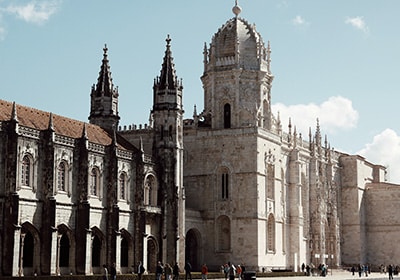
The monastery is massive, with a long stone façade and an entrance into a quiet, vaulted church. Inside, you’ll find the tomb of Vasco da Gama and several other notable figures from Portuguese history.
The real highlight, though, is the cloister. It’s a large, open courtyard surrounded by two levels of arched walkways. Every part of it, from the columns to the ceilings and railings, is carved with intricate details. It’s quiet and peaceful, a nice contrast to the busy street outside.
Allow at least an hour for your visit, especially if you want to explore the church and cloister. Tickets are required for the cloister, but the church is free to enter. Lines can get long, so buying tickets online in advance is a good idea.
Pro tip: Combine your visit with Belém Tower. They’re close to each other, and one ticket often covers both. Come early to beat the tour groups and get better photos in the cloister.
3. Alfama District

Walking through Alfama is the main attraction. There are no big-ticket sights you have to see as it’s more about the atmosphere. Expect tiled facades, overhead laundry lines, small family-run cafés, and fado music coming from open windows. It’s a place to slow down and explore on foot.
Popular stops include the Lisbon Cathedral, the Miradouro de Santa Luzia viewpoint, and the small local shops tucked into the ground floors of old buildings. Trams also pass through the area, including the famous 28 line, though it’s often easier to explore on foot due to the tight streets.
Alfama is hilly and uneven in parts, so wear comfortable shoes. It’s also one of the best neighborhoods to visit in the late afternoon or early evening when fado restaurants open and the light hits the rooftops just right.
Pro tip: Skip the restaurant flyers and instead look for a simple, no-frills tasca with locals inside.
4. São Jorge Castle (Castelo de São Jorge)
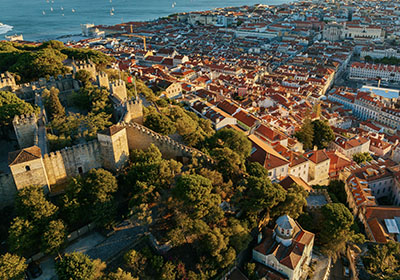
The site dates back centuries, with Moorish and Christian influences throughout history. Visitors can walk along the old stone walls, climb towers, and look out from various viewpoints. Inside the grounds, there are gardens, a small archaeological site, and a camera obscura that projects real-time images of the city.
It’s not a polished museum experience, as much of the charm is walking the walls and taking in the view. Plan for about one to two hours to explore at a relaxed pace. Tickets are required, and you can buy them at the entrance or online.
You can reach the castle on foot from Alfama, though it’s a steep climb. Taxis, tuk-tuks, and trams also go part of the way if you prefer to save your energy.
Pro tip: Go in the late afternoon. The light is perfect for photos, and the crowds tend to thin out as the day goes on.
5. Praça do Comércio
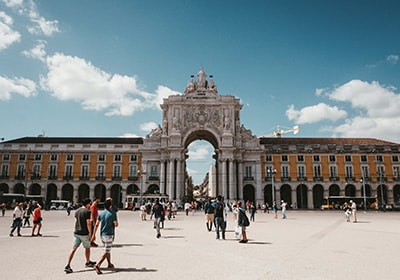
The square is more than just a photo stop, as it’s also a useful point of reference in the city. From here, you can walk into the Baixa district, head up to Chiado, or follow the waterfront path toward Belém.
The large archway at the square’s northern end, the Arco da Rua Augusta, leads into Lisbon’s pedestrian shopping street. You can go to the top of the arch for a view of the square and the river.
While there aren’t major attractions in the square, it’s a great spot to take a break, especially at sunset when the light hits the buildings. Plenty of places are nearby to grab a coffee, sit outside, and people-watch.
Pro tip: Skip the pricey riverside cafes and walk a block or two into Baixa. You’ll find the same coffee for half the price.
5 Must-See Hidden Gems in Lisbon
If you’ve already seen the main sights or just want some unusual things to do in Lisbon, these hidden gems are worth tracking down. From quiet gardens to unexpected art spaces, each one offers a side of the city most visitors miss.
6. Palace of the Marquises of Fronteira
This palace is a bit off the usual tourist trail, but it’s one of Lisbon’s hidden gems. Located just outside the city center, the Palace of the Marquises of Fronteira is a 17th-century residence that’s still partially lived in today. It’s best known for its gardens and colorful tile work.
The palace was initially built as a hunting lodge and later became the home of the Fronteira family. Parts of it are open to the public on guided tours, which take you through rooms filled with antiques, portraits, and painted ceilings.
The highlight for many visitors, though, is the garden. It features detailed azulejos (ceramic tiles), fountains, statues, and hedged pathways, all arranged with a mix of elegance and a bit of eccentricity.
Visits are by guided tour only and usually in the morning, so plan ahead. It’s quieter than Lisbon’s bigger sights, making it a peaceful break from the busy downtown.
You can get there by taxi or bus or walk from the nearby Jardim Zoológico metro station if you’re up for a bit of a hill.
Pro tip: If you’re into photography, this is one of the best places in Lisbon for tile work. Go on a sunny day for the best light in the gardens.
7. Torel Garden (Jardim do Torel)
Torel Garden is a small, quiet park tucked into a hillside above central Lisbon. It’s not as well-known as some of the city’s larger viewpoints, but it offers a relaxed atmosphere and great views without the crowds.
You’ll find benches under trees, a small café, and a lookout with a wide view over Avenida da Liberdade and the downtown rooftops. It’s a popular spot for locals to read, take a break, or enjoy a slower pace. The garden also has a seasonal splash pool that opens in summer, often used more by locals than tourists.
You can reach Jardim do Torel by taking the Lavra funicular or walking up from the city center. It’s steep but manageable. This is the kind of place that rewards you for going a little off-route.
There’s not much to “do” here in a typical tourist sense—it’s more about catching your breath, taking in the view, and maybe grabbing a coffee. It’s a good spot to rest between sights or end your day before heading downhill again.
Pro tip: Bring a snack or drink and stay until just before sunset. It’s usually quiet, and the light over the city is worth the short climb.
8. Thieves Market (Feira da Ladra)

The market runs on Tuesdays and Saturdays, starting early and going until mid-afternoon. Stalls sell a bit of everything: old books, vinyl records, antiques, tiles, clothes, tools, handmade crafts, and the occasional odd item you didn’t know existed. Some things are valuable, some are just fun to browse.
This isn’t a polished, curated market—it’s a mix of professional sellers and locals clearing out their attics. Haggling is common, and prices range from very cheap to surprisingly high depending on the item and the seller.
Even if you don’t plan to buy anything, it’s a good spot for a walk and a bit of people-watching. The vibe is casual, and you’ll often hear live music or catch locals chatting over coffee at nearby kiosks.
Pro tip: Bring cash, wear comfortable shoes, and get there early for the best finds. For a full morning out, pair it with a visit to the Pantheon or nearby viewpoints.
9. Tapada da Ajuda
Tapada da Ajuda is one of Lisbon’s lesser-known green spaces, but it’s a great place to escape the crowds. Located near Alcântara and not far from Belém, it’s a large, wooded park that once served as a royal hunting ground. Today, it’s part of the University of Lisbon’s agricultural institute, so it’s both public and somewhat tucked away.
The space feels different from Lisbon’s other parks—it’s bigger, quieter, and more natural. Expect dirt paths, open fields, shaded picnic areas, and great views over the 25 de Abril Bridge and the Tagus River. There’s also a small botanical garden and sometimes temporary exhibits or events hosted by the university.
It’s not a tourist spot, which is part of the appeal. You won’t find cafes or rentals here, so bring whatever you need—especially if you’re planning a picnic or a longer walk. It’s ideal for a peaceful break in nature without leaving the city.
Access is easiest by car or rideshare, but you can also reach it by bus or a 15–20 minute walk from Alcântara or Belém.
Pro tip: Go on a weekday morning if you want the place nearly to yourself. It’s one of the quietest places in Lisbon with a view.
10. Quinta do Mocho Murals

Located in the suburb of Sacavém, this public housing neighborhood has transformed into an open-air art gallery, with over 100 large-scale murals covering the sides of buildings.
The project started in 2014 as a local initiative to bring new life and visibility to an area often overlooked. Artists from Portugal and around the world were invited to paint the buildings, and what started as a grassroots effort quickly became one of the largest mural collections in Europe.
It’s one of the more enchanting free things to do in Lisbon. You just walk the neighborhood and take it in. Some murals span entire facades, while others are tucked between buildings. The work is bold, varied, and tied closely to themes of identity, struggle, community, and cultural pride.
Getting there requires a bit of planning. You’ll need to take a train or bus from Lisbon’s city center to Sacavém, then walk into the neighborhood. It’s best to go during the day.
Pro tip: If you’re not sure where to start, consider joining a local street art tour. Some residents now offer guided walks that add context and history to the experience.
5 Museums That Are Worth a Visit
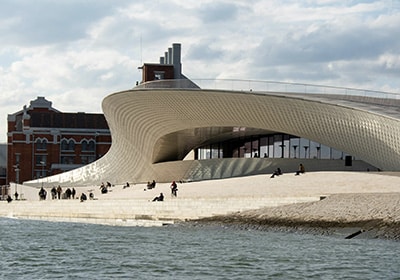
11. Calouste Gulbenkian Museum: A quiet, well-curated museum featuring everything from Egyptian artifacts to European paintings. It’s a good choice if you want variety without overwhelm. The surrounding gardens are also worth a walk.
12. National Museum of Ancient Art: Focused on Portuguese and European art from the Middle Ages through the 19th century. Highlights include paintings, sculptures, and decorative arts, with great river views from the upper floors.
13. Berardo Collection Museum: A modern and contemporary art museum in Belém showcasing works by Warhol, Picasso, and other big names. Easy to pair with a visit to the nearby monastery or tower.
14. Museum of Art, Architecture and Technology (MAAT): Known as much for its building as its exhibits, it mixes contemporary art with tech and architecture themes right on the waterfront.
15. Carmo Archaeological Museum: Set inside the ruins of a Gothic church, this small museum offers a mix of artifacts and history in a dramatic setting. A good add-on if you’re already in the Chiado area.
Why should you visit Lisbon?
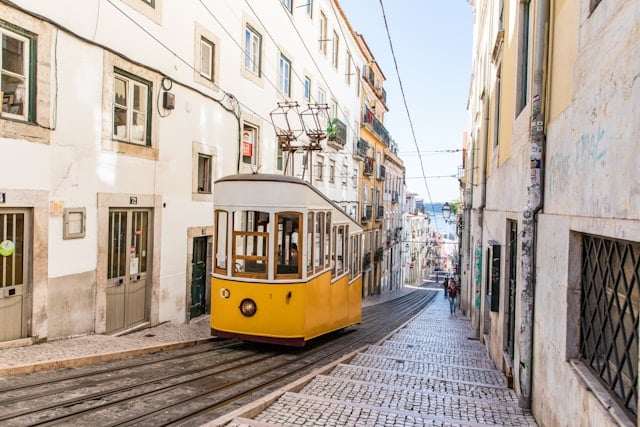
Start with a walk through the historic center near Baixa and the city center, then ride the iconic Santa Justa elevator (also known as the Elevador de Santa Justa) for sweeping views of the city.
You’ll see beautiful buildings, tiled facades, and historic landmarks at every turn. The Carmo Convent and Lisbon Castle—formally Castelo de São Jorge—are perched high above it all. Their castle grounds are perfect for sunset views.
In recent years, Lisbon has also made a name for itself in food and wine. From food tours in Cais do Sodré to Michelin-starred restaurants and trendy wine bars, the mix of traditional Portuguese dishes and modern twists is everywhere.
Be sure to sample Portuguese wine and try Portuguese classics like custard tarts—especially the original pastéis de Belém, also known as pasteis de Belem, baked daily using a closely guarded secret recipe.
You’ll find traditional fado music in the Bairro Alto district or at places like Clube de Fado, where fado singers perform over dinner and local wines. For more culture, visit the National Tile Museum (aka the Tile Museum) and the striking Padrão dos Descobrimentos, or explore UNESCO World Heritage Sites like the Torre de Belém and Saint Jerome’s National Palace.
Other musts include a stop at Miradouro da Graça or São Pedro de Alcântara for scenic views, and a visit to the lively Pink Street, which lights up at night. The Santa Justa tram ride and the historic building of the Time Out Market round out a city that blends past and present with ease.
Lisbon is walkable, photogenic, and full of surprises. Whether you’re riding a tram, relaxing at a rooftop bar, or standing in awe of the 18th-century architecture rebuilt after the great earthquake, the experience is always layered, rich, and uniquely Lisbon.
Why choose Global Citizen Solutions for your Immigration Visa?
GLOBAL APPROACH BY LOCAL EXPERTS
- GCS has offices located across Portugal.
- Members of the US-Portugal and UK-Portugal Chambers of Commerce in Portugal, and the Investment Migration Council (IMC).
- Our expert team can help you throughout your journey to secure your Visa.
100% APPROVAL RATE
- Our successful track record in applications provides reassurance to applicants.
- We have helped clients from more than 35 countries secure residency in Portugal.
ALL-ENCOMPASSING SOLUTION
- With a single channel of communication, our approach ensures that you have complete clarity on your application.
- Our BeGlobal® Onboarding System allows for a total flow of information.
TRANSPARENCY AND PRIVACY
- Our pricing is clear and detailed, you will not face any hidden costs.
- All data is stored within a GDPR-compliant database on a secure SSL-encrypted server.
Frequently Asked Questions About Things to Do in Lisbon
What should I not miss in Lisbon?
Don’t miss visiting Belém Tower, Jerónimos Monastery, and Alfama in Lisbon. Explore the Time Out Market for local cuisine, ride Tram 28 through historic neighborhoods, and watch the sunset at Miradouro da Senhora do Monte. Include a day trip to Sintra for palaces and scenic views.
Are there free things to do in Lisbon?
Yes, Lisbon offers several free activities. Visit the beautiful Miradouros (viewpoints), explore the Alfama neighborhood, and walk along the scenic streets of Baixa. You can also enjoy the famous Jardim da Estrela, visit the Lisbon Cathedral, or relax at the beaches. Many museums offer free entry on specific days.
Are there things to do in Lisbon with kids?
Lisbon offers many kid-friendly activities. Visit the Lisbon Oceanarium, one of Europe’s largest aquariums. Explore the interactive Pavilion of Knowledge Science Museum. Ride tram 28 for a fun tour of the city. Play at Parque Eduardo VII or enjoy the zoo. Several attractions include hands-on exhibits for children.
Are three days in Lisbon enough?
Three days in Lisbon is enough to see the highlights and get a feel for the city—especially if you plan well. You won’t see everything, but you’ll cover a good mix of big sights, neighborhoods, and local spots.
What is Lisbon best known for?
Lisbon is best known for its historic architecture, vibrant neighborhoods like Alfama and Bairro Alto, scenic viewpoints, and the iconic yellow trams. It is also famous for its pastéis de nata, Fado music, and landmarks such as Belém Tower and Jerónimos Monastery.
What’s a good day trip from Lisbon?
A good day trip from Lisbon is Sintra, located 40 minutes by train. Visit the colorful Pena Palace, Moorish Castle, and Quinta da Regaleira. The town also offers scenic views and traditional pastries like travesseiros. Trains run frequently, making it ideal for a full day getaway.
When is the best time to visit the main attractions?
The best time to visit the main attractions in Lisbon is early morning between 8:30 a.m. and 10:00 a.m. on weekdays. This avoids crowds at popular sites like Jerónimos Monastery, Belém Tower, and Pena Palace in Sintra. Spring and fall offer mild weather and fewer tourists overall.
Are there any unusual or hidden things to do?
Unusual or hidden things to do in Lisbon include exploring the underground Roman Galleries (open only a few times a year), visiting the quirky Pharmacy Museum, and riding the private elevator inside Hotel Mundial for rooftop views. Alfama’s secret courtyards and Fado bars also reveal a quieter side of the city.

 Gizane Campos
Gizane Campos


